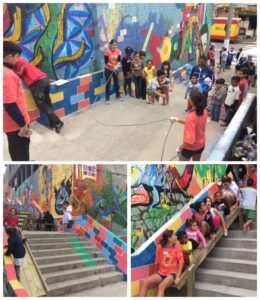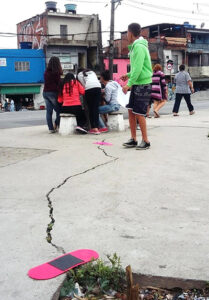Small-Scale Initiatives to Overcome Violence with Education
By Maria Rubio
Introduction
In 1996, Jardim Angela, a district located in the southwestern part of São Paulo, Brazil, was listed by the United Nations as the most violent region in the world with an annual rate of 116.23 murders per 100,000 inhabitants (Folha, Online, 2006). With high rates of violence and denial of basic infrastructure, Jardim Angela lacks educational opportunities and struggles with a low rate of cultural institutions and a deficit of public space. The average number of public cultural facilities for every 100,000 inhabitants in São Paulo is around 4.0. In Jardim Angela, this number is approximately 0.61, while Moema—one of the whiter and richer neighborhoods in São Paulo—has 6.81 such facilities per 100,000 residents. Moreover, 2010 IBGE data shows that Jardim Angela has the highest rate of black people in São Paulo.
When we think of favelas in Brazil, we typically picture a uniform typology with high-density brick constructions on top of the hills. However, there are many unique communities found within each favela. For example, Jardim Angela is home to at least 20 different communities, each with its own identity and capacity to overcome social issues confronting the neighborhood. This case shows how public schools, professors, and community members in partnership with non-profit organizations and governmental agencies have worked to overcome violence in Jardim Angela, developing small-scale educational initiatives for new generations of residents.
Analysis
Located in the south of Jardim Angela, a community known as Fundão do Jardim Angela is home to one of many educational initiatives to overcome violence. In 2007, the director of the local public kindergarten EMEI Chácara Sonho Azul formed a partnership with the NGO Associação Cidade Escola Aprendiz in order to develop art projects and cultural activities such as dance and theater performances, seeking to strengthen the students’ bond with the school as an inviting space for parents and the community. At the same time, the EMEI Chácara Sonho Azul emerged as a key center for educational opportunities, integrating learning with everyday urbanism. By developing walking trips for children, professors allow the students to explore their community under safe supervision and learn about the city. For example, taking children to the street market allows children to expand their sense of place while supporting local businesses. The school has also developed an agroforestry initiative that exposes children to gardening, contributing to their nutrition while rescuing local identity and connections with the land.
Another educational initiative in Jardim Angela led by Instituto Cidade em Movimento (IVM) in partnership with Cidade Ativa and public and private sponsors seeks to preserve and improve alleys, walkability, and public spaces through participatory planning. In Jardim Angela, alleys contribute to a powerful sense of community and place attachment, and 80% of residents showed interest in participating in improving the alleyways. Cidade Ativa studied the conditions of existing paths, including the slope, the width of the passages, the conditions of the stair treads, and other safety elements, and, through interviews conducted in 14 different passages, documented residents’ concerns about lighting conditions, the safety of steps and handrails, and drainage issues.
Following the study, two alleyways in the Nakamura community were chosen for revitalization efforts. The revitalization initiative brought people from the community, especially youth, together to share and discuss potential solutions, thus integrating local residents’ knowledge in the decision-making process. By developing activities such as mosaic production, urban furniture construction, and graffiti design with graffiti artists from Ciclo Social Arte, the project provided opportunities for a new generation to engage in participatory approaches to planning and design. After the revitalization project, the number of people using the public stairs increased, and interviews showed that the number of residents feeling unsafe decreased from 53% to 31% after the transformation.
A third initiative, Rede Ubuntu Education, seeks to provide educational opportunities for marginalized community groups, in particular black teenagers. Ubuntu offers free classes for young people who are studying for exams to enter university. While some of the best public universities in Brazil are free, tests are extremely competitive, and exam scores are the only method used for student selection. Because of that, privileged groups with sufficient financial resources to attend high-quality schools have better chances of getting into free universities. Ubuntu also started Sarau Apoema, a group that provides space for youth to share their artistic talents, such as poems, talks, photography, and dance, and has come to serve as a symbol of the resilience of a new generation to overcome violence.
Implications
By including children and teenagers in activities that respect their knowledge, they receive learning opportunities while strengthening their self-confidence, their right to the city, and their right to exist. Children and adolescents see themselves as partners in urban transformation processes, allowing them to reframe their experience with discrimination by participating in the development of future visions. For planners, involving youth in the planning process exposes them to non-traditional forms of knowledge while advancing equality in urban planning. In particular, the case of Jardim Angela suggests that planners should explore arts-based practices to engage with youth through participatory planning, and especially through methods that facilitate alternative storytelling practices. Storytelling can be understood as an decolonial method in planning, fostering critical thinking and shaping new imaginative planning alternatives (Ortiz, 2002).
Supporting such community-based initiatives is essential to fight violence while building opportunities for new generations. At the same time, however, we need to keep in mind that ‘informal’ communities like Jardim Angela and others around the world are still facing many challenges that need to be addressed by municipal planning authorities. While residents of Jardim Angela have developed important strategies of self-governance, building relationships with external actors is necessary to solve fundamental structural challenges and strengthening their influence over planning decisions and practices, as Nunbogu et al. (2018) demonstrate in the case of self-governance in Accra, Ghana. Ultimately, as Nunbogu et al. (2018) suggest, planners should learn from local knowledge and engage with complex networks of planning actors to co-produce solutions to problems that are too broad for communities to handle themselves.

Photo of Initiative Mind the Step from Cidade Ativa at Jardim Nakamura. Source

Photo from initiatives at EMEI Chácara Sonho Azul. Source

Photo of the Curativos Urbanos workshop. Source
